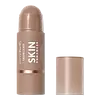What's inside
What's inside
 Key Ingredients
Key Ingredients

 Benefits
Benefits

 Concerns
Concerns

 Ingredients Side-by-side
Ingredients Side-by-side

Caprylic/Capric Triglyceride
MaskingIsostearyl Neopentanoate
EmollientMica
Cosmetic ColorantPolyethylene
AbrasiveSynthetic Fluorphlogopite
Simmondsia Chinensis Seed Oil
EmollientKaolin
AbrasiveDicalcium Phosphate
AbrasiveSynthetic Beeswax
Emulsion StabilisingSynthetic Wax
AbrasiveAluminum Hydroxide
EmollientStearalkonium Bentonite
Gel FormingCalcium Sodium Borosilicate
Polyhydroxystearic Acid
EmulsifyingSilica
AbrasivePropylene Carbonate
SolventPentaerythrityl Tetra-Di-T-Butyl Hydroxyhydrocinnamate
AntioxidantPunica Granatum Pericarp Extract
Skin ConditioningTin Oxide
AbrasiveRubus Idaeus Leaf Extract
Skin ConditioningVitis Vinifera Fruit Extract
Skin ConditioningIron Oxides
CI 77891
Cosmetic ColorantCI 42090
Cosmetic ColorantCI 15985
Cosmetic ColorantCI 45410
Cosmetic ColorantCI 15850
Cosmetic ColorantCI 19140
Cosmetic ColorantCaprylic/Capric Triglyceride, Isostearyl Neopentanoate, Mica, Polyethylene, Synthetic Fluorphlogopite, Simmondsia Chinensis Seed Oil, Kaolin, Dicalcium Phosphate, Synthetic Beeswax, Synthetic Wax, Aluminum Hydroxide, Stearalkonium Bentonite, Calcium Sodium Borosilicate, Polyhydroxystearic Acid, Silica, Propylene Carbonate, Pentaerythrityl Tetra-Di-T-Butyl Hydroxyhydrocinnamate, Punica Granatum Pericarp Extract, Tin Oxide, Rubus Idaeus Leaf Extract, Vitis Vinifera Fruit Extract, Iron Oxides, CI 77891, CI 42090, CI 15985, CI 45410, CI 15850, CI 19140
Ethylhexyl Palmitate
EmollientPolyethylene
AbrasiveHydrogenated Polyisobutene
EmollientLauroyl Lysine
Skin ConditioningDiisostearyl Malate
EmollientTriethylhexanoin
MaskingBis-Diglyceryl Polyacyladipate-2
EmollientSilica
AbrasiveOzokerite
Emulsion StabilisingPolyhydroxystearic Acid
EmulsifyingPersea Gratissima Oil
Skin ConditioningHydrogenated Vegetable Oil
EmollientCandelilla Cera
EmollientDisteardimonium Hectorite
StabilisingCaprylyl Glycol
EmollientBehenyl Behenate
EmollientVaccinium Macrocarpon Fruit Extract
AstringentTocopheryl Acetate
AntioxidantPentaerythrityl Tetra-Di-T-Butyl Hydroxyhydrocinnamate
AntioxidantTocopherol
AntioxidantPrunus Domestica Seed Oil
Skin ConditioningCI 77891
Cosmetic ColorantCI 77491
Cosmetic ColorantCI 77492
Cosmetic ColorantCI 77499
Cosmetic ColorantMica
Cosmetic ColorantCI 77742
Cosmetic ColorantEthylhexyl Palmitate, Polyethylene, Hydrogenated Polyisobutene, Lauroyl Lysine, Diisostearyl Malate, Triethylhexanoin, Bis-Diglyceryl Polyacyladipate-2, Silica, Ozokerite, Polyhydroxystearic Acid, Persea Gratissima Oil, Hydrogenated Vegetable Oil, Candelilla Cera, Disteardimonium Hectorite, Caprylyl Glycol, Behenyl Behenate, Vaccinium Macrocarpon Fruit Extract, Tocopheryl Acetate, Pentaerythrityl Tetra-Di-T-Butyl Hydroxyhydrocinnamate, Tocopherol, Prunus Domestica Seed Oil, CI 77891, CI 77491, CI 77492, CI 77499, Mica, CI 77742
Ingredients Explained
These ingredients are found in both products.
Ingredients higher up in an ingredient list are typically present in a larger amount.
Ci 77891 is a white pigment from Titanium dioxide. It is naturally found in minerals such as rutile and ilmenite.
It's main function is to add a white color to cosmetics. It can also be mixed with other colors to create different shades.
Ci 77891 is commonly found in sunscreens due to its ability to block UV rays.
Learn more about CI 77891Mica is a naturally occurring mineral used to add shimmer and color in cosmetics. It can also help improve the texture of a product or give it an opaque, white/silver color.
Serecite is the name for very fine but ragged grains of mica.
This ingredient is often coated with metal oxides like titanium dioxide. Trace amounts of heavy metals may be found in mica, but these metals are not harmful in our personal products.
Mica has been used since prehistoric times throughout the world. Ancient Egyptian, Indian, Greek, Roman, Aztec, and Chinese civilizations have used mica.
Learn more about MicaPentaerythrityl Tetra-Di-T-Butyl Hydroxyhydrocinnamate (long name, huh?) is a synthetic antioxidant.
It is used to help stabilize other antioxidants or prevent the color from changing in a product.
As an antioxidant, it helps fight free-radical molecules. Free-radical molecules are capable of damaging our cells and other genetic material. Thus, antioxidants may reduce the signs of aging.
This ingredient is oil-soluble.
Learn more about Pentaerythrityl Tetra-Di-T-Butyl HydroxyhydrocinnamatePolyethylene is a synthetic ingredient that helps the skin retain moisture. It is a polymer.
It is also typically used within product formulations to help bind solid ingredients together and thicken oil-based ingredients. When added to balms and emulsions, it helps increase the melting point temperature.
Polyhydroxystearic Acid is a soft wax made from castor oil.
It is is a texture thickener, emulsifier, and film-former. Emulsifiers prevent ingredients from separating, such as oils and waters.
Polyhydroxystearic Acid may not be fungal acne safe.
Learn more about Polyhydroxystearic AcidSilica, also known as silicon dioxide, is a naturally occurring mineral. It is used as a fine, spherical, and porous powder in cosmetics.
Though it has exfoliant properties, the function of silica varies depending on the product.
The unique structure of silica enhances the spreadability and adds smoothness, making it a great texture enhancer.
It is also used as an active carrier, emulsifier, and mattifier due to its ability to absorb excess oil.
In some products, tiny microneedles called spicules are made from silica or hydrolyzed sponge. When you rub them in, they lightly polish away dead skin layers and enhance the penetration of active ingredients.
Learn more about Silica